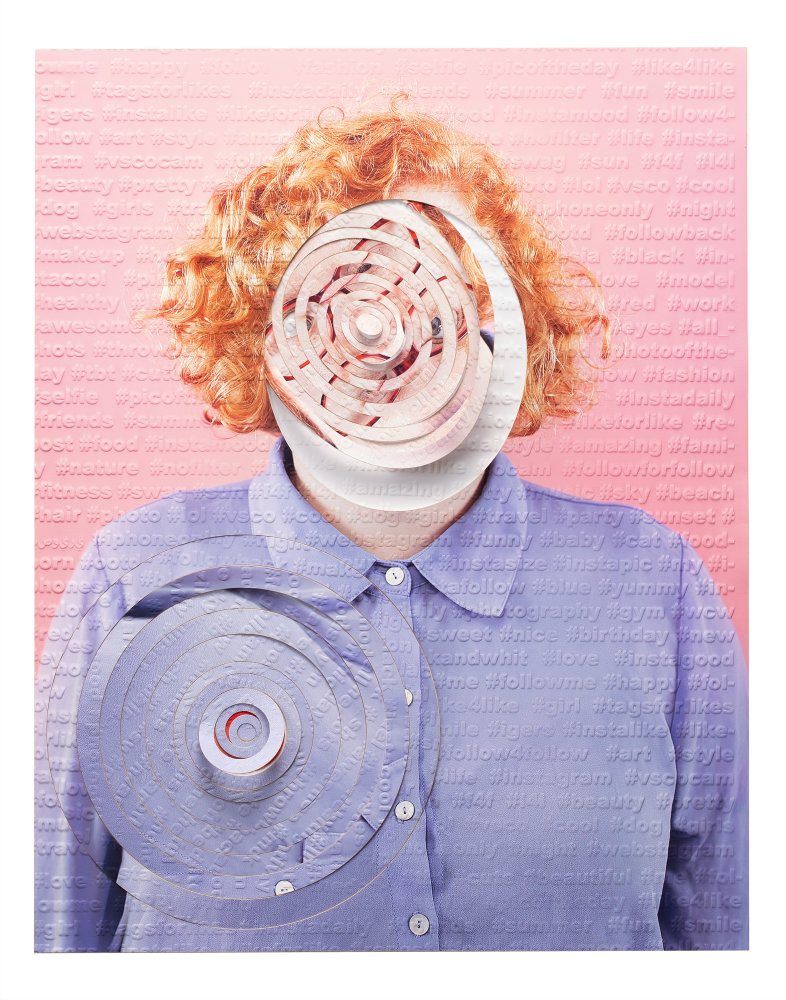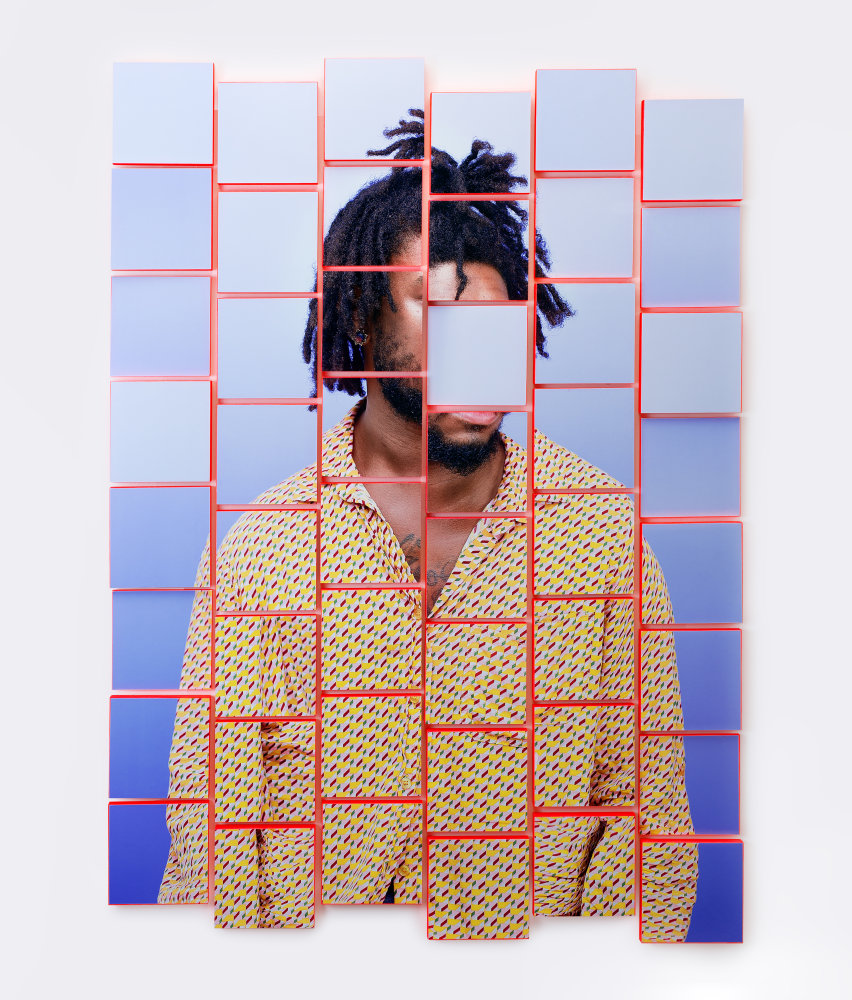
Karen Navarro, an immigrant from Argentina, with a heritage rooted in an indigenous people, now living in the United States, uses a photography-based multidisciplinary approach to self discovery, womanhood and the impact of social media on ourselves and others. All these concepts are woven together in her use of photography, collage and sculpture. Her work is, at the same time, non-traditional portraiture of others and self-portraiture. Her newest work, “The Constructed Self”, is a continuation of an examination of “self” that threads through all of her previous efforts.
Her pursuit in understanding “the self” is complicated by Navarro’s own belief that identity is “a cultural and social construct”, made complex by issues of identity, self-representation, race, gender, and need for belonging. Karen has stated “Much of my work is based on the premise that our social and cultural identities are a construction. We contain many identities that continually intersect and overlap. This intersectionality affects how we are perceived socially, and also how privileges and discrimination are attributed. How we are perceived by others has to do a lot with, among other, context, other’s people social and cultural background and personal experiences. All of this is not independent and it’s traversed by the dominant Euro-centrist hegemonic vision narrative—which can lead to biased or stereotyped perceptions of other people. My work asks us to consider who informs all this and what social constructs are at work in the process.” This investigation into a sense of “self” is sharpened as “each individual’s face is often depicted hidden, dissected, or blurry”, making the viewer more intently examine all the clues in the image, and to avoid a snap stereotypical flash of judgement about who and what a person may be in any category we might want to conveniently deposit them, for our own measure of like, dislike, friendship or prejudice.
“The Constructed Self” deconstructs the portrait of a person to create a puzzle like structure of movable parts. Unlike a puzzle where pieces ultimately fit into a pre-determined image, Navarro’s pieces may have no pre-defined order, just like no one person, except by accident of birth and genes, place and environment have a specific pre-defined self. She describes it this way: “My identities intersect coming together to construct my multiple sense of Self, like a puzzle. For this reason, I made each of the works in this series so that the pieces can be rearranged to create a new piece, just like we can change as people or present one of our multiple selves in different situations. Although I do not appear in the pictures I see the works as self-reflective and the process becomes a form of meditation that reflects my efforts to reconstruct and to make sense of my own identity.” A true artist, Navarro is following a heartfelt passion that she has to share in her own feelings of belonging in an adopted land, captive in a generation whose sense of self is entwined with social media.
Navarro’s journey toward “The Constructed Self” begins with an earlier portfolio of work, “Soft Objects”. That sense acceptance, and “self love”, starts to be examined in this earlier body of work. It is here that Navarro first uses distortion as part of her visual communication. Navarro pushes back, with her visual imagery, against the frustration many women may feel of the perfect female body. “Throughout history, women and their image have been stereotyped. … somehow, society still holds stringent ideas of what constitutes the perfect female image. .. When a modern woman looks in the mirror, she perceives any deviance from those ideas as a flaw.” This pressure on women to feel acceptance and belonging through a pre-defined image of what “self” should look like, imposed upon them through all the social media, is what Navarro challenges in “Soft Objects”. By pressing and compressing flesh, lips and breasts against oneself or glass, Navarro clouds that sense of self and balance. “The distrust of the natural beauty of one’s body is thus disclosed in this project, making a statement about the progress of modern society in the acceptance of the female body as nature intended it to be.”
Deconstruction was Navarro’s first project in 2016. Later she did Soft Objects in 2018. Navarro, with her focus on women, created “a series of indirect self-portraits that explores the relationship between perfection and failure, identity, isolation and ambiguity.” These were simpler images, less confrontational than “Soft Objects”, more playful and colorful, and rely more on visual cues, with reference to staging and props.

©Karen Navarro, Subject #7 variation 1, 2019
It is with her next series, “El Pertenecer en Tiempos Modernos (Belonging in Modern Times)”, that Karen finds her visual voice, and broadens her narrative to all people, and that sets a stage for “The Constructed Self”. Here, she physically breaks an image into components by laser cutting each image in unique patterns. She takes literally her concept of “deconstruction” from the prior work. In some of the images, she cut the images into squares, with some raised or lowered so the 2D image was no longer flat, but a dimensional image taking up a larger space and distortion. Using social media, Navarro draws into her studio random unfamiliar people through the internet willing to sit before her lens. Where the “El Pertenecer en Tiempos Modernos” images are cut into all different configurations, spirals shreds, and inclusion and exclusion of facial features, “the Constructed Self” is a more regimented dissection of squares.
Navarro tells us that Cubism influenced her visual expression. Cubism was started by Pablo Picasso, George Braque, and Juan Gris in the period before World War 1. The Tate Museum (UK), on its website description of Cubism, states: “By breaking objects and figures down into distinct areas – or planes – the artists aimed to show different viewpoints at the same time and within the same space and so suggest their three dimensional form. In doing so they also emphasized the two-dimensional flatness of the canvas instead of creating the illusion of depth.” Indeed, This art movements is visible in both “El Pertenecer en Tiempos Modernos” and “Constructed Self”.
While we see “them”, the physical “construction” of the image represents the fabricated self that any of us puts forward in social media that we want others to see and share to “externally validate our identity online”. The need for belonging is like an addictive drug. “‘Belonging is intrinsic to our humanity and integral to our understanding of ourselves. While the need for community transcends time, the means to develop one’s “tribe” has transformed from the physical to the digital realm and has subsequently impacted how we view ourselves in this interconnected world.” There is only a part of our self that we try to allow out into this public stage. Unfortunately for some, too much of our self image is released, and we pay dearly in public perception and prosecution. There is a lesson not readily evident in Navarro’s work that living and sharing our lives in cyberspace is dangerous. For many of us, by our very nature, we want to be part of something; so, we sell ourselves willingly into this constructed, artificial environment.
Technology, both in our use, and in the messages delivered to us, mold and shape our own perception of ourselves and others. For Navarro, Facebook and Instagram are two significant stages where these conflicts play out. She finds her subjects through social media. Navarro asks them to dress using the color of the social network organization through which they met. As a frame of reference, she’ll emboss paper in the “Belonging in Modern times” series with the top 100 hashtags used at that time to reflect that person’s sense of belonging in these cyberspace platforms. These hashtags are secret symbols of identity for Navarro. “Acting as an invisible tattoo, these words are aspirational, a call to wear the seal of the virtual tribe you wish to belong to.”
Deconstruction intensified in the “Constructed Self” series where the image is made up of building blocks, clearly 3D, obviously a photographic portrait, but a random arrangement of the “who” this person “is” by scrambling our visual cues. In other cases, she has reduced the images to multiple strips, to be hung and spun as a mobile. Yet, she says “The Constructed Self is not about social media”.

©Karen Navarro, Twisted I, 2020
Navarro has put all of our perceptions of self and others on display in her images. It is a lesson in existential responsibility. The individual has to be free and responsible, through their own acts, to be who they want to be, not what others say they are, or how others, or a society, feel a person should act or exist in this world. Navarro says, referencing Jean-Paul Sartre’s first principle of existentialism, that: “I exist by defining myself in the world at each moment and in relationship to others.” All of us, in one sense or another, want to feel like we belong.
As part of “The Constructed Self”, Navarro has yet again expanded and diversified her art with neon constructions with particular words and phrases. These phrases include: “I am Large”, “I contain multitudes (a reference from Walt Whitman’s open “Song of Myself”), “When is that we truly belong?”, and “Real, Unreal, Surreal”. Each of these catch our eye, focus our attention and confront the viewer with words that must be absorbed and thought about. You cannot just walk by these neon lighted works without thinking.

©Karen Navarro, I contain multitudes, 2021

©Karen Navarro, Puzzled, 2020
Her images are like a mirror. What judgments we make about a person in Navarro’s art, as she has done for own self awareness, may, indeed, be relevant as if a self portrait of ourselves. Whether one agrees or not, she is creating a visual sensitivity to imbalance in acceptance/prejudice, race and power. She is pointing out the impact and importance of knowledge. Through her art, she argues for the world to be more conscious of equitable and fair treatment for all people. Navarro comments that: “I am questioning and asking us to rethink this and understand that colorism, skin-tone bias, and how we see skin color today was something imposed a long time ago by the oppressor group and that today is ingrained in every aspect of our lives and in our very own psyche. We need to be able to understand this first to be able to rebuke it.”
In yet another sense, Navarro wants us to accept imperfection in ourselves and in life. “No todo en la Vida es color de rosa.”… that translated literally into “not everything in life is rosy.” All in life is truly not perfect. We are not perfect. But people should not be persecuted or demeaned for their “imperfections”, beliefs, skin color or appearance. Navarro has commented “they are actually not imperfections. “Flaws” or what does not fit the canonical view of society are seen as imperfections but they are really not. It’s part of our own natural body” With “The Constructed Self”, Navarro, with certain of the works, allows the acquirer to install all the squares in their own arrangement. This unique engagement of viewer with artist is a partnership in self examination as we construct the “self” image we will live with. With the other works from “The Constructed Self”, a visual fragmentation or assembly of words become embedded in our visual memory. The beauty in these images hide and embrace a serious lesson once we absorb all the pieces and explore below the surface.
